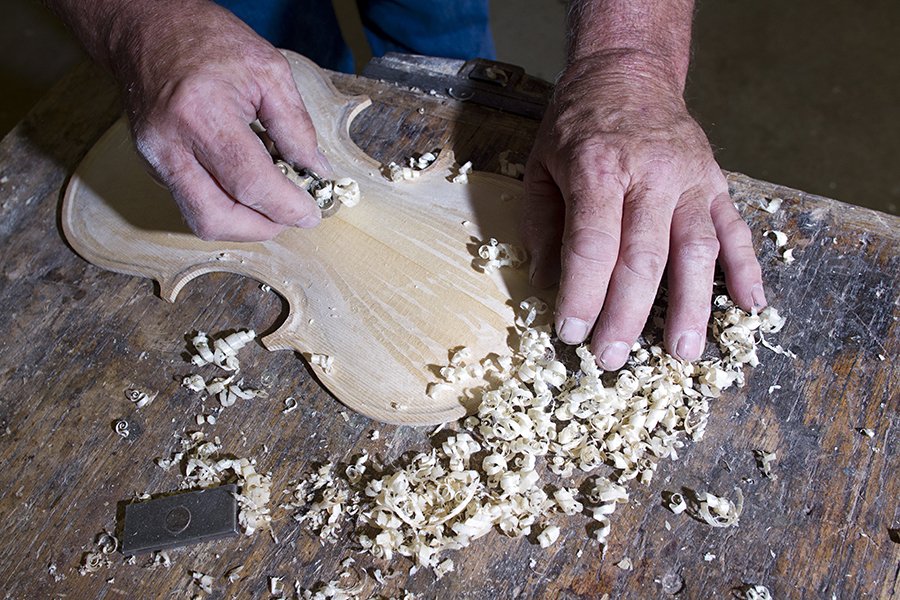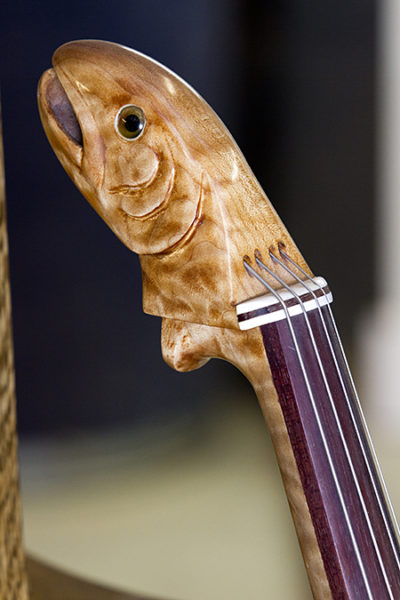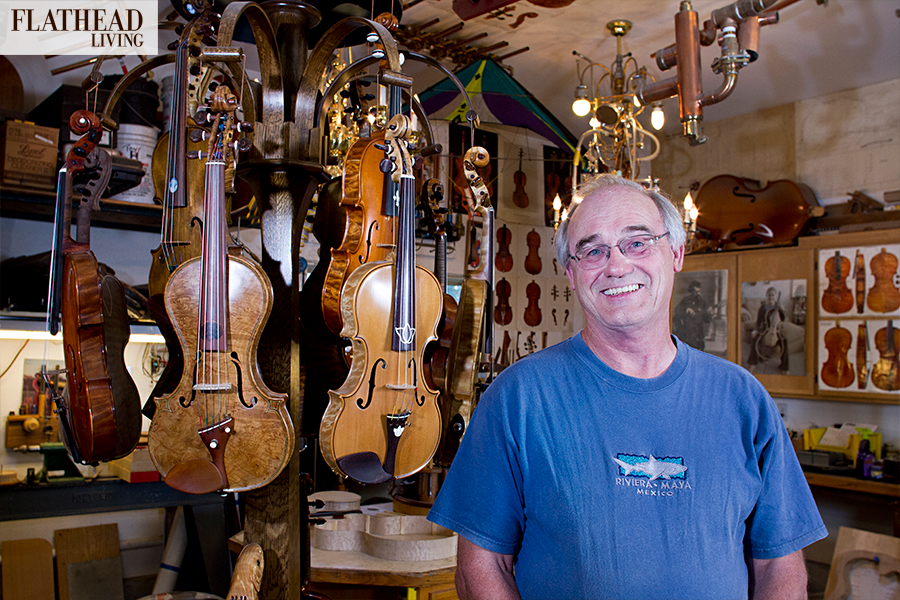Tom Simensen is a full-time professional plumber, but you’d be forgiven for not immediately noticing the evidence in his Kalispell workshop. After all, gorgeous handcrafted violins tend to attract the eye more than pipefittings and basin wrenches.
The idea of building a violin first occurred to Simensen in 1994 after his son started playing the instrument for grade-school orchestra. His son approached him one day with an earnest question: “Can you make me a violin?”
“I don’t think so,” Simensen recalls telling him. “I don’t know anything about the violin. He said, ‘Let’s go to the library.’”
Sure enough, the Simensens stumbled upon a basic violin-building primer at the library. With a guide in hand, Simensen, handy by nature and trade, dove into the project.
“I thought it was a crazy idea at first,” he said recently. “But it changed my life.”
Today, Simensen, operating under the name Fat Cat Fiddles, boasts an impressive collection of finely rendered violins, both acoustic and electric, as well as an electric cello. Each instrument takes upwards of 150 hours to finish, with hand-held precision tools — planers, chisels, scrapers, clamps — and meticulous detailing defining the craft.
Given that he continues plumbing as a day job, Simensen acknowledges that his shop serves as a well-worn second home where he spends weekends, nights and whenever else he can squeeze in time to pursue his luthier passion.

Before instruments, Simensen had dabbled in woodworking, making furniture such as cabinets and shelves, but he loves the precision of violinmaking, which encompasses everything from the craftsmanship to the shop requirements.
“I can set up in a shop that’s 10, 15 square feet and have everything I need,” he said.
Joan Renne, a longtime and respected violin instructor in the Flathead Valley, marvels at Simensen’s commitment to centuries-old Italian violinmaking techniques, which rely on hand tools.

“It’s incredibly arduous,” Renne said.
Renne and Simensen collaborated on a viola, working a few hours a week on it for three years. Renne walked away with a new appreciation for an instrument she has played and taught others to play for decades.
“I learned so much; it was really great working with him,” she said. “Tom is a very intelligent guy. He’s gifted.”
Simensen notes that each detail of a violin’s structure affects its musical quality: type and thickness of wood, weight, size, dimensions, the list goes on.
“Every little thing you do on a violin has a bearing on the sound,” he said.
Even if the instrument’s essential form and process have remained relatively unchanged for centuries, Simsensen delights in pushing the boundaries and experimenting while honoring tradition. He points to an electric violin with a pickup that he built for his son as a turning point.
“That’s when I started getting a little wacky and getting off the beaten path,” he said.
Take, for example, his 4-string electric violin dubbed “The Freedom Fiddle,” which features an intricately detailed eagle head instead of a normal scroll at the top of the neck. Simensen started building the violin for a client in 1998, but after the client grew impatient, Simensen, who hadn’t taken a deposit, suggested he look elsewhere.
After the violin sat untouched for a few years, Simensen, inspired by a friend who carves bird sculptures as a hobby, started tinkering with the eagle head again, making it more realistic. Simensen acknowledges his “turtle pace” on the one-of-a-kind violin, chipping away over many years, fine-tuning his carving craftsmanship as he progressed.
The final product, which he centrally showcases at exhibits, is stunningly attention-grabbing: quilted maple wood on the back and sides; Port Orford cedar on the top plate; finger board, pegs, end button and tail piece carved from black palm wood; nut, saddle, pegs and tail piece accented with ivory.
Simensen left extra wood on the back to carve feathered wings, as well as extra wood on the top to carve breast feathers. Simensen describes the instrument’s sound as “something to behold.”
“It’s kind of my crowning jewel,” he said.
At the Northwest Handmade Musical Instrument Exhibit in Portland in April, “The Freedom Fiddle” turned a lot of heads and generated plenty of praise.

“It was like flies to honey,” he said. “It was pretty exciting to see.”
Another unique undertaking was an electric violin he made for Renne. In addition to burl maple, Simensen used a piece of mountain mahogany that Renne had found and stored away for 30 years, enamored with its beauty.
When Simensen cut into the mahogany, he discovered it was riddled with bored holes from insects.
“We thought it was useless until we saw what a spectacular pattern had been made viewing it from the end grain,” Simensen said.
Lo and behold, Renne’s gorgeous “Electric Sky Dancer” emerged from the remnants of an insect infestation.
“I never dreamed it would become what it did,” Renne said of the mahogany.

Simensen also likes to tell the story of one of his daughter’s friends asking him to build a cello for her. Simensen asked her if she knew how to play the cello. She said no.
“So I said, ‘Come back to me when you can play,’” he recalls saying.
About eight years later, she returned, cello-playing skills firmly in tow. Simensen followed through on his promise with “Josie’s Cello.”
Simensen is trying to convert his violinmaking passion into a more viable business, attending events such as the exhibit in Portland and the upcoming February Wintergrass Music Festival in Bellevue, Washington. Lucrative or not, Simensen has no plans to slow down.
“I just love doing it so much,” he said.
For more information, visit www.fatcatfiddles.com.
Read more of our best long-form journalism in Flathead Living. Pick up the fall edition for free on newsstands across the valley.
